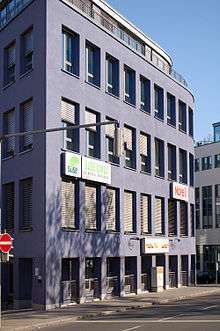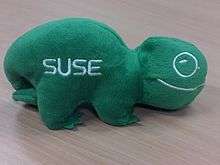SUSE
 | |
| Subsidiary | |
| Industry | Computer software |
| Founded | Fürth, Germany (September 2, 1992)[1] |
| Founder |
|
| Headquarters | Nuremberg, Germany |
Area served | Worldwide |
Key people | Nils Brauckmann (President and GM) |
| Products |
|
Number of employees | 750[2] |
| Parent | Micro Focus International |
| Website |
www |

SUSE (SUU-zah)[3] is a German-based, multinational, open-source software company that develops and sells Linux products to business customers. Founded in 1992, it was the first company to market Linux for the enterprise. It is also the primary sponsor of the community-supported openSUSE Project which develops the openSUSE Linux distribution. The company is a wholly owned subsidiary of Micro Focus International.
History
On 2 September 1992, Roland Dyroff, Burchard Steinbild, Hubert Mantel and Thomas Fehr founded the Software and Systems Development Corporation (German: "Gesellschaft für Software und Systementwicklung mbH"). The name SuSE was an acronym for Software- und System-Entwicklung (Software and Systems Development).[1] The first Linux product sold was an extension of the Linux distribution Slackware, which was delivered on 40 floppy disks. The company translated the distribution in cooperation with the Slackware founder Patrick Volkerding into German. While the core of the distribution remained Slackware, in May 1996, SuSE shipped its first own distribution based on the Jurix distribution published by Florian La Roche.
In 1997, SUSE opened an office in Oakland, California, and in 1998, moved the corporate office from Fürth to Nuremberg. In December 1998, the name was changed from S.u.S.E. to SuSE. In the following years, SUSE opened a total of six national and four international (USA, Czech Republic, Great Britain and Italy) branches. On 25 November 2002, Richard Seibt became CEO. It is distributed by TriTech Distribution Limited in Hong Kong.[4]
Acquisition by Novell
On 4 November 2003, Novell announced the acquisition of SuSE Linux AG at a price of US$210 million.[5] Novell had been migrating away from the NetWare kernel and used this acquisition as a migration path for its customers.[6] The acquisition was completed on 13 January 2004,[7] and the name was changed from SuSE Linux AG to a Novell, Inc. subsidiary under the name SuSE Linux GmbH and SUSE Linux Products GmbH. SUSE Linux Products GmbH was entirely responsible for the development of the SUSE Linux distribution and was led by Markus Rex. During the transfer, both the partner and the sales organizations were integrated into Novell. Richard Seibt became CEO of Novell EMEA and left on 9 May 2005.
In August 2005, the openSUSE community project launched to open up the development of SUSE Linux for external users and developers. SUSE Linux Enterprise has since been developed using the openSUSE community.
Acquisition by Attachmate
Novell was in turn acquired by The Attachmate Group on 27 April 2011.[8] Under its new owner, SUSE remained a separate company.[9] By June 2012, many former SUSE engineers who had been laid off during Novell's ownership had been brought back.[2]
Attachmate and Micro Focus merger
On 20 November 2014, The Attachmate Group and Micro Focus International finalized their merger, making Micro Focus International SUSE's new parent company.
Products

Starting with the launch of the SUSE Linux Enterprise 10 platform in July 2006, the SUSE Linux Enterprise 10 platform was the basis for both the server and desktop with an almost identical code base.
Server
The primary server Linux distribution from SUSE is SUSE Linux Enterprise Server targeted to large organizations for physical, virtual and cloud workloads. All versions are available for multiple processor architectures, including Intel x86, AMD x86-64, IBM Power, IBM S/390 and zSeries, and Intel Itanium. Trial versions of SUSE Linux Enterprise Server 11 and 12 are available on the site.[10]
Offerings based on the Server product
- SUSE Linux Enterprise Server for SAP Applications[11] - a Linux operating system optimized for SAP workloads
- SUSE Linux Enterprise Point of Service - a Linux operating system for the retail industry that includes a version of Linux tailored for user touch points and in-store servers
- SUSE Linux Enterprise High Performance Computing[12] - an infrastructure solution for high performance computing
- SUSE Linux Enterprise High Availability Extension[13] - an integrated suite of open source HA clustering and storage replication[14] technologies.
- SUSE Linux Enterprise Real Time Extension - an add-on to SUSE Linux Enterprise Server that turns the general-purpose operating system into a real-time operating system.
Special editions of the Server product
SUSE Linux Enterprise Server has several optimized editions created in the context of the respective partnerships. These editions are derived from the base Server product:
- SLES for VMware[15] (entitlement was included in VMware vSphere. Product end of availability has been announced )
- SLES for Amazon EC2[16]
- SLES for Microsoft Azure[17]
Desktop
In the desktop family, the primary distribution is SUSE Linux Enterprise Desktop, the successor to Novell Linux Desktop. SUSE also offers the SUSE Linux Enterprise Workstation Extension that adds desktop features to the SUSE Linux Enterprise Server.[18] The popular LibreOffice office productivity suite is also distributed and supported by SUSE and sold as LibreOffice from SUSE.[19]
Management and Cloud
SUSE software management and cloud tools include:
- SUSE OpenStack Cloud - an automated cloud computing platform based on OpenStack for deploying and managing Infrastructure-as-a-Service private clouds
- SUSE Manager - a comprehensive Linux server management tool based on Spacewalk for package- and patch management, system provisioning and monitoring
- SUSE Enterprise Storage - a software-defined storage tool based on Ceph enabling the use of commodity servers and disk drives for cost-effective, resilient, and scalable storage
- SUSE Studio[20] - a free web-based tool for building system images containing operating system, configuration, applications and data
References
- 1 2 "SUSE History". SUSE. Retrieved 29 January 2013.
- 1 2 DiDidio, Laura (June 2012). "Michael Miller Q&A: SUSE and Attachmate Group". ITIC. Retrieved 29 January 2013.
- ↑ Novell & HP (14 October 2011). How do you say SUSE?) (Motion picture).
- ↑ "tritech". www.ttdist.com. Retrieved 2016-01-04.
- ↑ Shankland, Stephen (4 November 2003). "Novell to acquire SuSE Linux". CNET. Retrieved 29 January 2013.
- ↑ "Novell Announces Agreement to Acquire Leading Enterprise Linux Technology Company SUSE LINUX". Novell. 4 November 2003. Retrieved 29 January 2013.
- ↑ "Novell Completes Acquisition of SUSE LINUX".
- ↑ "The Attachmate Group Completes Acquisition of Novell". The Attachmate Group. 27 April 2011. Retrieved 29 January 2013.
- ↑ "SuSE becomes separate Attachmate division". ComputerWeekly.com. 18 May 2011. Retrieved 29 January 2013.
- ↑ "Linux Downloads". SUSE. Retrieved 29 January 2013.
- ↑ "SUSE Linux Enterprise Server for SAP Applications".
- ↑ "SLE High Performance Computing".
- ↑ "SLE High Availability Extension".
- ↑ DRBD
- ↑ "SLES for VMware".
- ↑ "SLES for Amazon EC2".
- ↑ "SUSE for Azure".
- ↑ ""SUSE Linux Enterprise Workstation Extension".
- ↑ "SUSE Partners with Collabora to Deliver Commercial LibreOffice Support".
- ↑ "SUSE Studio On-line".